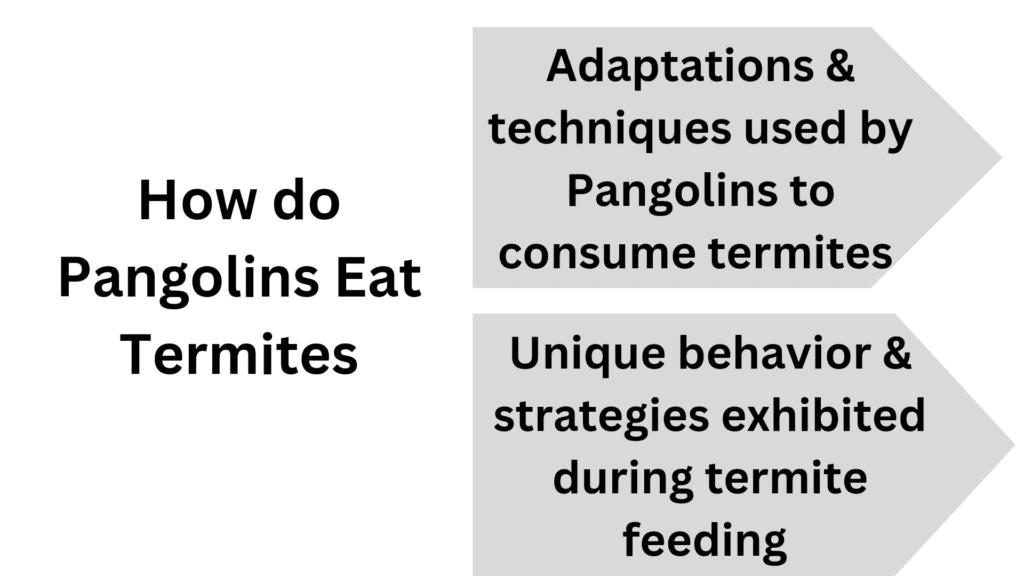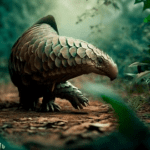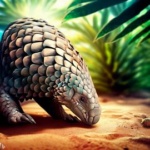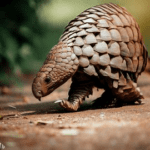Pangolins, what are they? Misunderstood creatures with scales resembling artichokes and long snouts like a vacuum cleaner. They love to feast on termites. But there’s more to their diet than just that.
These critters have powerful claws and sticky tongues that allow them to dig into termite mounds and extract their prey effortlessly. But they also eat ants, beetles, larvae, and other invertebrates found in their habitat.
Pangolins have a long history with humans. Ancient Chinese culture revered them for their mythical healing powers and protection against evil spirits. Unfortunately, this reverence has led to their demise. They are hunted for their scales and meat in illegal wildlife trade markets.
Key Takeaways
- Pangolins are insectivorous mammals that primarily feed on ants and termites.
- While pangolins are known for their unique scales, their diet consists mainly of insects.
- Termites are a significant part of a pangolin’s diet, providing them with essential nutrients and energy.
- Pangolins have long, sticky tongues that they use to catch termites and ants.
- The consumption of termites by pangolins helps control termite populations in their habitats.
- Pangolins play a crucial role in maintaining the balance of ecosystems by controlling insect populations.
- The decline in pangolin populations due to illegal hunting and habitat loss can have negative effects on termite control and ecosystem health.
- Conservation efforts should focus on protecting pangolins and their habitats to ensure the continued control of termite populations.
What are pangolins?

Image: Pangolin Wikimedia Commons CC By 2.0
To better understand what pangolins are, delving into their physical characteristics provides a comprehensive solution. By exploring their unique features and traits, such as their scaly exteriors and powerful claws, you’ll gain insight into the fascinating world of these enigmatic creatures.
Physical characteristics of pangolins
Pangolins are special! Let’s explore what makes them so interesting.
Their body structure is unique. They have a small head, long snout, and sharp claws. These claws help them climb trees, dig burrows, and protect them. Plus, they have scales covering their whole body, which protect them from danger. Plus, they have long tails for balance. Also, their tongues are incredibly long and sticky, meaning they can easily catch insects.
Did you know there are 8 species of pangolins? They range in size, with some reaching up to 1 meter long. Plus, female pangolins don’t have mammary glands like other mammals. Instead, they make a special milk-like substance from special glands.
Remember: Pangolins are endangered due to illegal trafficking and habitat loss. We must do our best to protect them for future generations.
Diet of pangolins
To better understand the diet of pangolins, dive into the section “Diet of pangolins” with a focus on “General overview of pangolin diet” and “Specific focus on termites as part of their diet.” Learn about the diverse array of foods pangolins consume and explore their particular fascination with termites.
General overview of pangolin diet
Pangolins have a unique diet of ants and termites, which they catch using their long, sticky tongues. They can consume thousands of insects in a day! Plus, some species also eat other small invertebrates such as larvae, beetles, and worms.
These shy animals are nocturnal hunters and use their sharp claws to dig into mounds and nests. When threatened, they curl up into a ball, protecting their soft underbelly with their tough scales. This makes it difficult for them to eat since they can’t uncurl easily.
An interesting story about pangolins is from the African savannah. A researcher saw one bravely make its way through an army of biting ants, all in pursuit of a termite nest. Despite the adversity, the resilient pangolin persevered and found its bounty.
We can learn a lot about pangolins’ relationship to their environment by studying their diets. Knowing this helps us preserve their habitats so that these remarkable creatures can thrive for generations to come.
Specific focus on termites as part of their diet
Pangolins have an appetite for termites. They have special adaptations to detect and eat these insects. To gain insight into their dining habits, let’s take a look at the table below:
| Species | Types of Termites Eaten | Quantity Consumed |
|---|---|---|
| Asian Pangolin | Odontotermes spp. | Up to 70 million/year |
| African Pangolin | Macrotermes spp. | Up to 80 million/year |
The Asian pangolin enjoys Odontotermes spp., and the African pangolin prefers Macrotermes spp. Both species consume an incredible amount of termites each year – 70 million and 80 million respectively.
In addition, pangolins also eat ants and larvae. This adds essential nutrients to their diet.
Fun fact: If you ever meet a pangolin in the wild, interact with caution and respect. After all, how do they eat termites? With a side of wing and a sprinkle of exoskeleton – delicious!
How do pangolins eat termites?

To better understand how pangolins eat termites, dive into the adaptations and techniques they employ during termite consumption. Witness the unique behaviors and strategies pangolins exhibit while indulging in their favorite meal. Discover the exciting world of pangolins and gain insight into their fascinating feeding methods.
Adaptations and techniques used by pangolins to consume termites
Pangolins have incredible adaptations for consuming termites. They have long, sticky tongues that can reach far into termite tunnels. A flick of the tongue can grab thousands of termites! Plus, their strong scales protect them from bites and stings.
These special features make pangolins amazing termite eaters. They have adapted to use their claws to dig, their sense of smell and hearing to find termites, and their strong jaws to crush the exoskeletons. Plus, their saliva has enzymes that help break down the tough cellulose of termites.
It’s remarkable how pangolins have evolved to be so good at getting nutrition from termites. Sadly, they are the world’s most trafficked mammal due to their scales and meat being highly valued in some countries. Who needs a tool belt when pangolins have built-in termite launchers?
Unique behaviors and strategies exhibited during termite feeding
Let’s explore some of the awesome behaviors pangolins possess when it comes to eating termites!
The prehensile tongue is perfect for sticking into termite nests.
When scared, they roll up in a ball, protected by their tough scales.
These scales also protect against bites.
Pangolins use their sharp claws to dig into termite mounds and get the insects quickly.
They swiftly move through vegetation to locate termite colonies easily.
Plus, they can find these colonies with their acute sense of smell.
This lets them navigate dense forests or grasslands well and hunt down their prey.
We can learn a lot from their feeding strategies about adaptation and resourcefulness.
Termites may not like it, but it’s a win-win for population control and pangolins getting their favourite food!
Benefits and significance of pangolins eating termites
To understand the benefits and significance of pangolins eating termites, delve into the impact of termite consumption on pangolin health and explore the relationship between pangolins and termite populations. Discover the valuable insights that come from observing these fascinating interactions in nature.
Impact of termite consumption on pangolin health
Pangolins depend on termites for their health. They’ve adapted to eat large quantities of termites. The termites give them protein, vitamins, and minerals. Plus, hunting and consuming them gives the pangolin mental stimulation and physical exercise.
It’s a win-win. The termites’ population grows, and the pangolins get an easy meal.
Relationship between pangolins and termite populations
Pangolins and termites have a special bond. Termites make up most of a pangolin’s food and this helps with controlling termite numbers.
A table can show how these two are connected. It would have info about the pangolin’s behavior and the effect on termites.
Pangolins have specific ways to eat termites. Their long, sticky tongue can get loads of termites out of the mounds quickly. This helps keep termite amounts in check.
Researchers found out that when pangolins weren’t around, termites increased. This shows us how important pangolins are for keeping the amount of termites low.
Pangolins may love termites, but they also bring us loads of laughter! They are the animal world’s funniest comedians!
Frequently Asked Questions
1. Do pangolins eat termites?
Yes, pangolins primarily feed on termites and ants as their main food source.
2. How do pangolins catch termites?
Pangolins have long, sticky tongues that they use to capture termites from termite mounds and nests.
3. Are termites the only food for pangolins?
No, while termites are their main diet, pangolins also consume other insects like ants, beetles, and larvae.
4. Can pangolins survive without eating termites?
No, termites and ants provide essential nutrients and moisture to pangolins, so they cannot survive without consuming them.
5. How many termites can a pangolin eat in a day?
A pangolin can consume thousands of termites in a single day, depending on its size and the availability of food.
6. Do all pangolin species eat termites?
Yes, all eight species of pangolins, including the Chinese, Indian, and African pangolins, feed on termites and ants.
Conclusion
Do pangolins have a taste for termites? After research and analysis, the answer is yes!
The scaly mammals hunt down their insect-dinner with skill.
Termites, with crunchy shells and protein-packed bodies, make an irresistible snack.
Pangolins use their long tongues to devour thousands of termites in a single session.
Their diet usually consists of ants and termites, but they can be versatile too.
Termites remain the top choice, though.
It’s amazing to see how pangolins have evolved to eat this food.
National Geographic’s research reveals that some species have adapted to hunt termites.
They have strong claws to dig into mounds, and a long sticky tongue to reach deep tunnels.
These evolutionary traits are further proof of the strong bond between pangolins and their favorite meal.
References




